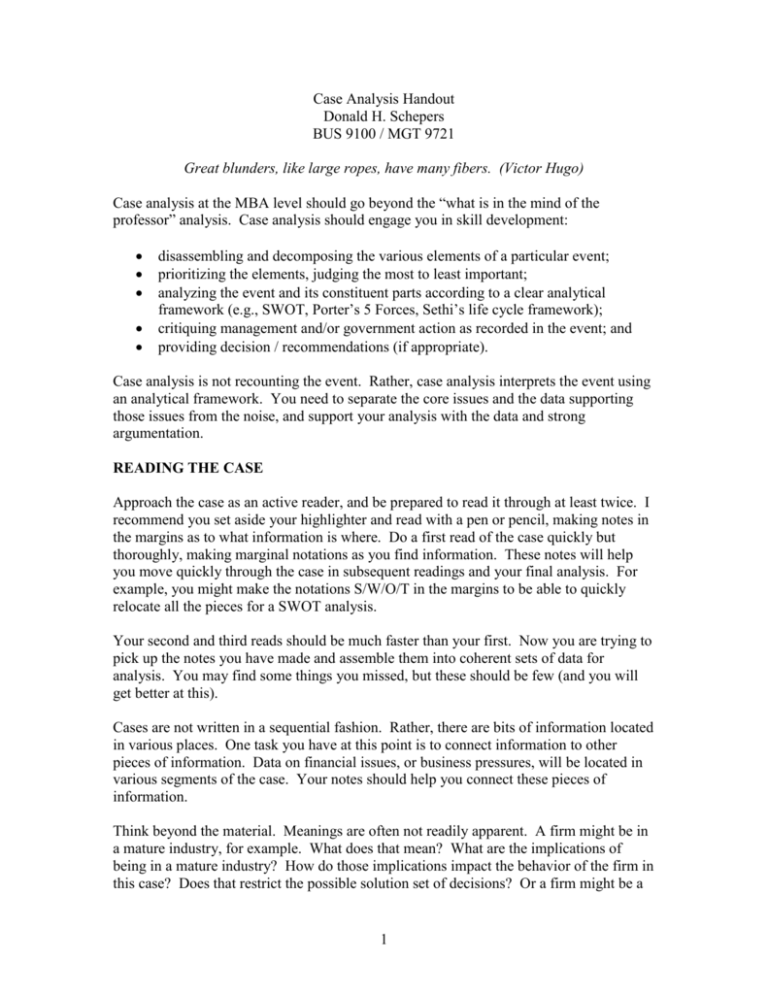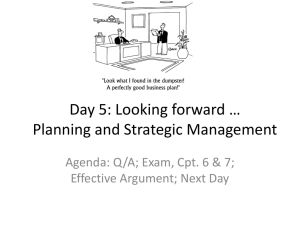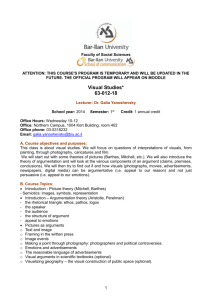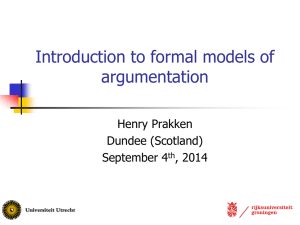Case Analysis Handout
advertisement

Case Analysis Handout Donald H. Schepers BUS 9100 / MGT 9721 Great blunders, like large ropes, have many fibers. (Victor Hugo) Case analysis at the MBA level should go beyond the “what is in the mind of the professor” analysis. Case analysis should engage you in skill development: disassembling and decomposing the various elements of a particular event; prioritizing the elements, judging the most to least important; analyzing the event and its constituent parts according to a clear analytical framework (e.g., SWOT, Porter’s 5 Forces, Sethi’s life cycle framework); critiquing management and/or government action as recorded in the event; and providing decision / recommendations (if appropriate). Case analysis is not recounting the event. Rather, case analysis interprets the event using an analytical framework. You need to separate the core issues and the data supporting those issues from the noise, and support your analysis with the data and strong argumentation. READING THE CASE Approach the case as an active reader, and be prepared to read it through at least twice. I recommend you set aside your highlighter and read with a pen or pencil, making notes in the margins as to what information is where. Do a first read of the case quickly but thoroughly, making marginal notations as you find information. These notes will help you move quickly through the case in subsequent readings and your final analysis. For example, you might make the notations S/W/O/T in the margins to be able to quickly relocate all the pieces for a SWOT analysis. Your second and third reads should be much faster than your first. Now you are trying to pick up the notes you have made and assemble them into coherent sets of data for analysis. You may find some things you missed, but these should be few (and you will get better at this). Cases are not written in a sequential fashion. Rather, there are bits of information located in various places. One task you have at this point is to connect information to other pieces of information. Data on financial issues, or business pressures, will be located in various segments of the case. Your notes should help you connect these pieces of information. Think beyond the material. Meanings are often not readily apparent. A firm might be in a mature industry, for example. What does that mean? What are the implications of being in a mature industry? How do those implications impact the behavior of the firm in this case? Does that restrict the possible solution set of decisions? Or a firm might be a 1 slow grower in a fast-moving, highly volatile industry. Can the firm pick up the pace? If not, what are the possible outcomes two or three steps down the road? Play out scenarios to think through the implications of possible decision sets. If there is financial data, make sure you tear it apart and understand the linkages between the finances and the case. Finances can support or contradict other facts in the case, and can often help you think beyond the material as it is presented. You may find the financial ratio analysis (attached) helpful in this regard. REASONING THE CASE There was an experiment done with MBA students. A case was given to a large class. The accounting students approached it as an accounting problem, the HR students as an HR problem, the finance students as a finance problem, and… you get the picture. Try not to be trapped by your own expertise. That expertise is helpful, but also blinding. At this point, you should ask yourself two questions (at least): What kind of a problem is this? What is the best approach to take in reasoning to a conclusion (i.e., what set of analytical tools might I use)? Your notes should help determine which tools might be most helpful. You will normally use more than one framework in developing your analysis of the case. Make sure you are clear why each is important. Otherwise, you will be less able to argue your point effectively. PREPARING YOUR WORK If you are preparing to be a discussant in class (i.e., this is not a written assignment for you), you should have your notes and analysis on a sheet or two of paper. By the time you sit down for class, the “I’ll remember this” promise often has faded in the blur of other classes or the workday. You have already spent a couple of hours (at least) at this, and 15-20 minutes more to formalize some notes will make your participation more effective. Make notes that highlight the tools you think are important, and the data that you use in each of those tools. Draw a SWOT grid, or a Porter’s 5 Forces, or an issue life cycle, and fill it out with the important points you want to contribute. Note the data you have connected in the case, and the thoughts you have on further issues outside the case. Roughly outline your argument to your conclusion about the case. If you are preparing a written assignment, you have to take those points just noted and put them on paper in such a way that I see a convincing argument to your conclusion. There are often a variety of solution possibilities to a case, and what matters therefore are 2 two things: that your conclusion responds to the major issues in the case, and that you have argued clearly and cogently to that conclusion. Each is important. To respond to the major issues, you must first have judged correctly on what those are, and relegated other issues to a minor place. Clearly state what you believe is important, and why you have come to that conclusion. You must also argue to your conclusion. This will typically involve clear analytical argumentation. Make sure you build your argument so that, as I read it, I can see each step moving to your conclusion. Having the time to put your work aside and re-read it a day or so later is helpful in discovering places where your argument may not be so clear. Two questions are very helpful before you finally decide on a course of action. What is the greatest weakness of your conclusion and argument? And what alternatives might there be to your conclusion? Probing these questions thoughtfully will firm up your position, or perhaps cause you to change your mind. Including the best alternative (along with its strengths and weaknesses) in your final write-up is often very helpful in demonstrating the strength of your solution. If you are using tools such as SWOT, 5 Forces, financial analysis, etc., do not put the whole item in the text. Add your SWOT grid (for example) as an appendix to your document. If you have items in the appendix, refer to them in parenthesis in the text of the paper. If you have items in the appendix that are not referred to in the text, either get rid of them or place the reference where it belongs. LENGTH OF WRITTEN ASSIGNMENTS Some assignments may only be a page in length, others will be longer. If the assignment is a page, think of it as an executive summary. State the conclusion and the meat of your argument in one page. This is a brutal but often helpful way to separate the truly important from the rest. If the assignment is longer, begin with an Executive Summary (no longer than 3-4 paragraphs for a 6 page paper), and then write the text of your argument. The summary should still be the roadmap: make sure the first page has your conclusion, along with the meat of the argument. The other pages are for elaborating your analysis. End with a very brief concluding paragraph noting your conclusion and the major points that led you to it. EVALUATING YOUR WORK How will you know if you are right or wrong? This question is the continual preoccupation of students and the eternal frustration of professors. Remember, cases have a variety of solutions, and your solution may be quite different from mine. That is not the criteria for evaluation. My categories are as follows: 3 Really, really wrong: There are two forms here. First, you reiterate the case with the occasional editorial comment, stating why something (in your opinion) was really bad (or perhaps really good). I know what happened in the case, and occasional editorial comments do not assist me in assessing your ability to analyze critically. The second form involves not taking a stand or forming solid judgments. Wherever the case leaves off (e.g., the CEO must decide a course of action, or the CFO is preparing a board presentation), ask yourself what must be done and take a stand. Be decisive. Mildly wrong: You are clear in your opinion of who/what performed well and/or poorly; you have made a decision, given advice, or in general, answered the case question. The typical problem here lies in argumentation, and as a consequence, your resolution may well be incomplete. Your argument fails in its logic, or recommendations appear at the end without clear linkage to analysis or argumentation. It is not enough to present data, you must interpret it by stating how the data supports your point. You also cannot ‘conveniently’ leave out contravening facts. If something does not support your point, you need to reconcile it in your analysis. At minimum, you need to state the fact and that you find it difficult to reconcile it with your analysis. And you cannot come to conclusions without arguing to those points. On target: Your judgments are clear and well-defended. Your analysis is robust, and able to deal with the facts of the case. Your analysis incorporates a sound framework. Your recommendations follow from (and are strictly limited by) the scope of your analysis. And your writing is clear. But what if I don’t agree with you? Note that in none of the above categories did I stipulate agreement with me. I am looking for clarity, cogency, analytical rigor, robust argumentation, and strong writing. I can’t fit it all into the page limit. You have to pick your battles. Managers live and die on judging and prioritizing. This is also where concise writing is an important skill. Make your point and move on. Use simple, declarative sentences: they are often the most efficient and clear means of communication. Okay, I kinda get it, now what sections do you want? I do not have a specific “case format”. I would, however, recommend you develop a professional style, beginning with an Executive Summary outlining your basic analysis and any conclusion you may have drawn, and then break down the elements of the case in supporting pages. Here are some general points you should be clear on before you start writing, but these are not sections of case writing. They are points for consideration so that your writing is clear. Identify the unit of analysis Does the problem arise from the action of one or a group of individuals? Is it a corporate problem, an industry problem, or a government problem? This is sometimes referred to as the “bad apples vs. bad barrel” dilemma. There can be both bad apples and bad barrels at the same time. Picking one as the main avenue for analysis (again, that pesky prioritization issue) will assist you in gaining clarity in your work. 4 Identify the cause for concern This is key to understanding the case: the “why should anyone care?” question. What is the main issue in the case? If it is a strategy case, what is happening in terms of the strategy? Has it gone off-track, or was there never a strategy to begin with? If it is a business and society case, what social good, in your opinion, is being threatened? How is it being threatened? How important is it that there be protection? Answering these questions will give you a better grasp on the key questions that need to be examined. You will also be able to assess relevant stakeholders. Finally, you will be able to condition your argument regarding a “best solution” on the cost/benefit ratio for the solution you propose. Be warned – simplistic answers are often misleading, if not outright wrong. For example, when Ford made and marketed the Pinto, people died in fiery crashes. You might contend that the social issue is that Ford made a bad car and people died. Not quite. Companies make both bad and good products, and people die under both conditions. No car maker makes a perfectly safe product. If they did, consumers could not afford it. Rather, one interpretation might be that Ford knowingly imposed a fatal risk on consumers, balancing corporate profit ($50 million) against a minimal ($6.45) per car fix, without informing consumers of the risk. If the fix had been available even as an option on the car, with a short paragraph explaining the risk, Ford might have been absolved. Instead, Ford made the decision for consumers. Lesson: identifying the key issue takes (and is worthy of) much thought. The more carefully you identify the key issue, the easier (and better) the rest of your work. The Two Basic Case Types Decision format cases These are cases where an individual (or group of individuals) are left at the end at some particular decision moment. Begin your case analysis with your decision, and then argue its justification. Your justification should include insights from class materials and discussions. This is not a simple gut-check, though that is often the first moment of decision. What concerns need to be in the mind of the decision maker in the case, and how might those best be resolved? Research format cases These are cases where there is no decision, but rather the case consists of the recounting of an event. Typically, these cases are well-known events, with known outcomes (e.g., Enron and its demise). The question then becomes the analysis of the corporate actions and strategies up to and after the event. 5









